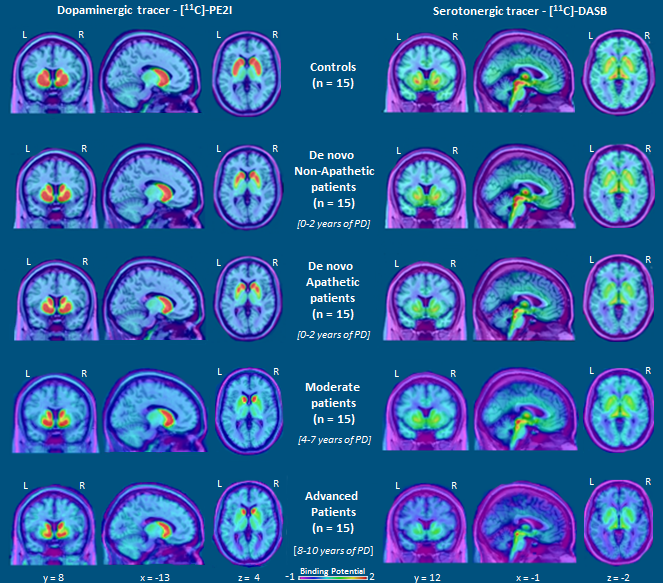Session Information
Date: Thursday, June 8, 2017
Session Title: Parkinson's Disease: Neuroimaging And Neurophysiology
Session Time: 1:15pm-2:45pm
Location: Exhibit Hall C
Objective: To explore the progression of DA and 5-HT lesions during the course of Parkinson’s disease (PD) and their respective contribution to the pathogenesis of neuropsychiatric signs.
Background: Many evidences suggest a disruption of several neurotransmitters in PD, beyond the dopaminergic (DA) one(1). A link between serotonergic (5-HT) alteration and occurrence of neuropsychiatric symptoms has been especially highlighted, from the early stages of disease(2). However, the respective evolution of DA and 5-HT lesions in PD course, as well as their specific role in related symptomatology, had never been simultaneously explored. Our aim was therefore to fill this gap by combining clinical and Positron Emission Tomography (PET) imaging approaches.
Methods: Sixty PD patients, i.e., 30 drug-free de novo patients (less than 2 year-disease duration), 15 mid-stage patients (4-7 year-disease duration), and 15 advanced patients (8-10 year-disease duration), as well as fifteen age-matched healthy controls, were enrolled. Fifteen de novo patients specifically presented apathy (LARS score ≥ -21). All subjects underwent detailed neurological and neuropsychological assessments, as well as two PET-scans using DAT and SERT transporters ligands ([11C]-PE2I and [11C]-DASB, respectively). Voxel-based approach was used to compare DA and 5-HT innervation between groups and to explore correlations with neuropsychiatric signs.
Results: All patients exhibited DA disruption in the nigrostriatal pathway, relative to controls. DA lesions were more pronounced in caudate nuclei in de novo apathetic patients and in more advanced ones. PD-group comparisons revealed worsening of DA depletion in the nigrostriatal projection targeting the posterior striatum (putamen) and pallidum with PD progression. The 5-HT system was also impacted by PD evolution, affecting progressively and widely the meso-cortical areas, thalamus and striatum. Interestingly, de novo apathetic patients elicited a 5-HT denervation pattern close to those of moderate-to-advanced ones [Figure]. Our data moreover suggest a link between the severity of anxiety and a 5-HT disruption in the subgenual ACC. The degree of fatigue was related to combined DA and 5-HT lesions in several cortical limbic areas.
Conclusions: These findings highlight progressive combined DA and 5-HT disruption in PD, which correlates with neuropsychiatric manifestations.
References: (1). Brichta et al. Advances in the pharmacological treatment of Parkinson’s disease: targeting neurotransmitter systems. Trends in Neurosciences 2013; 9; 543-554.
(2). Maillet, A. et al. The prominent role of serotonergic degeneration in apathy, anxiety and depression in de novo Parkinson’s disease. Brain 2016; 139; 2486-2502.
To cite this abstract in AMA style:
A. Maillet, E. Météreau, E. Favre, E. Lhommée, H. Klinger, D. Le Bars, A. Castrioto, V. Sgambato-Faure, L. Tremblay, E. Broussolle, P. Krack, S. Thobois. Serotonergic, Dopaminergic Disruptions and Related Non-Motor Features Throughout the Course of Parkinson’s Disease: A Transversal PET Study [abstract]. Mov Disord. 2017; 32 (suppl 2). https://www.mdsabstracts.org/abstract/serotonergic-dopaminergic-disruptions-and-related-non-motor-features-throughout-the-course-of-parkinsons-disease-a-transversal-pet-study/. Accessed January 1, 2026.« Back to 2017 International Congress
MDS Abstracts - https://www.mdsabstracts.org/abstract/serotonergic-dopaminergic-disruptions-and-related-non-motor-features-throughout-the-course-of-parkinsons-disease-a-transversal-pet-study/


